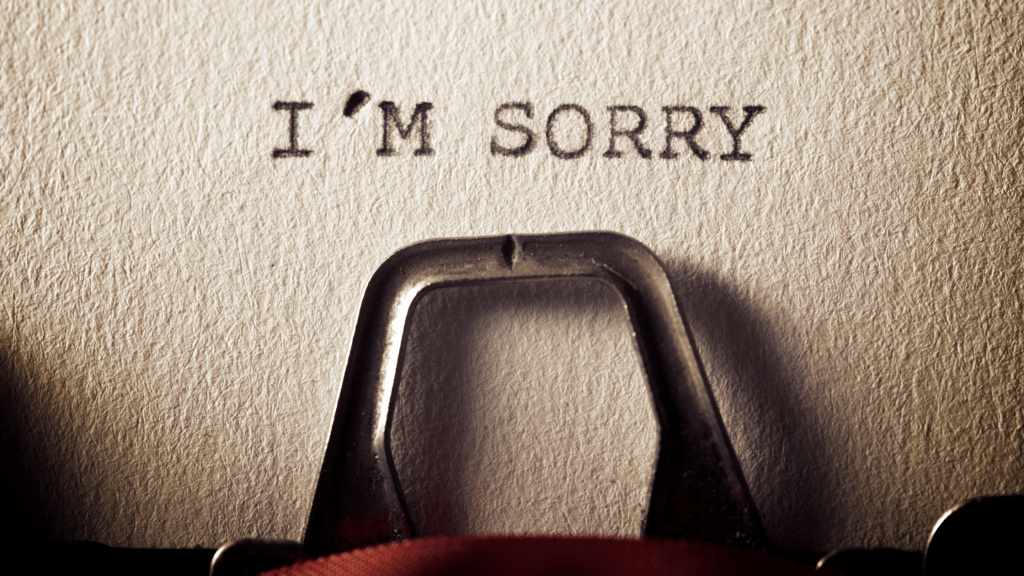
Ever had someone apologize to you in a way that felt more like a slap in the face than a genuine admission of fault? And, on the flip side, have you ever gotten an apology that felt like a warm cup of cocoa on a chilly day? I’ve been fortunate enough to experience both – thankfully more of the comforting kind. Growing up, my mom was all about good manners and kindness. She had this saying she’d pull out whenever my sister and I weren’t being friendly or forgot our “sorries.” “Put on a smile,” she’d say. And when we messed up, she’d chime in with, “Say you’re sorry – it’s like a magic fixer-upper.” She meant that apologizing could make things better, like sprinkling fairy dust on a mess. Oh, and if we dared to say “sorry but,” well, let’s just say we’d be in for a lecture – and not the fun kind!
Apologizing Gone Wrong
In my leadership seminars, we give major props to apologizing. Why? It’s a big deal because, let’s face it, people simply don’t trust leaders who can’t apologize. Additionally, they need to apologize correctly – there’s a right and wrong way to say it. In my work with couples, I’ve heard a common complaint: “Their apologies just don’t cut it.” (Okay, the real words might be a tad saltier.)
Whether it’s at work or in personal relationships, apologies can totally backfire if your tone and body language scream “I don’t really mean it.” And don’t even get me started on email apologies – The problem with the latter is that you can’t see the person or hear them – all you can go by is the words and the tone of the email. (Yes, emails do have a tone of voice.)
Apology Fails and Redos
While a heartfelt apology can heal hurt feelings and patch up your reputation, a bad apology can fan the flames and do even more harm than the very thing you’re apologizing for! So, let’s dive into some common apology mistakes, and how to avoid them:
Mistake 1: Apology with a “But”
Saying “I’m sorry, but” isn’t really an apology; it’s more like an excuse. “I’m sorry, but I was having a bad day” may sound like a mea culpa, but it’s really a deflection.
Rectification: “I’m sorry for what I said/did. I was in a bad space, but that doesn’t make it right. How can I make it up to you?“
Mistake 2: Good Start, Bad Finish
An apology that starts well but ends poorly isn’t an apology; it’s an argument starter. “I’m sorry I did it. You triggered me though…” Hello, disagreement central! Can you hear the toxic cycle of a new argument being born here? I certainly can!
Rectification: “I’m sorry I said that. I didn’t like your tone, but I shouldn’t have reacted that way. How can we do it differently in future?” (We need to understand that it is a two-way street at times, without apportioning blame.)
Mistake 3: The Intent Mix-up
“I didn’t mean to hurt you” isn’t an apology. It’s not about your intention; it’s about your actions.
Rectification: “I’m sorry for what I did and for hurting you. What can I do to make it better? How can I make amends?”
Mistake 4: Passive-Aggressive Play
“I’m sorry you feel that way” is a sneaky non-apology. It sounds like sorry but feels like sass. Here’s the problem: you can’t be sorry for how another person feels – it’s a way of using the words “I’m sorry,” but without any investment in the apology.
Rectification: If you’re truly sorry, say, “I’m sorry my words/actions had such an effect on you. I will be more aware of what I say and how I say it in future.”
Don’t forget:
An apology needs to be sincere. It needs to show that the person apologizing is taking responsibility for what they did or said, showing remorse, and sharing how they intend to make amends going forward.
After the Apology
But here’s the hard truth: an apology is not enough. You’ve got to back it up with action. An apology needs legs to stand on; otherwise, it’s like a fancy outfit on a mannequin – pretty, but not functional. After the apology, it’s necessary to show, by how you speak and behave, that you’re putting in the work to change.
Being able to apologize sincerely, without getting defensive or huffy, is a sign of maturity and strength. It shows that you’re not too big or important to be vulnerable – It shows you’re strong enough to admit your „goof“ and fix it.
So, say you’re sorry and let’s keep the peace. (Thanks, Mom!)
What’s your distinctive approach to mastering the art of apologizing? How do you infuse authenticity and depth into your apologies? Your wisdom is invaluable – share your reflections!
